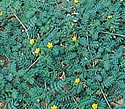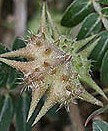 Puncturevine, also known as goatshead and devil’s thorn, is an annual that is very widespread in the world and US but is especially adapted to growing in dry climates such as found in southwestern US. It is a member of the Zygophyllaceae family which also includes the creosote bush (Larrea tridentate.) Puncturevine likes full sun and tolerates poor soil. It can be found in disturbed sites such as wasteplaces, roadsides, pastures, parks, fields and gardens. The generic name, Tribulus, refers to the resemblance of the fruit to a caltrop, a weapon that has spikes arranged so that one of the spikes is pointed up no matter how the caltrop is positioned.
Puncturevine, also known as goatshead and devil’s thorn, is an annual that is very widespread in the world and US but is especially adapted to growing in dry climates such as found in southwestern US. It is a member of the Zygophyllaceae family which also includes the creosote bush (Larrea tridentate.) Puncturevine likes full sun and tolerates poor soil. It can be found in disturbed sites such as wasteplaces, roadsides, pastures, parks, fields and gardens. The generic name, Tribulus, refers to the resemblance of the fruit to a caltrop, a weapon that has spikes arranged so that one of the spikes is pointed up no matter how the caltrop is positioned.
Description
 Plants are usually low growing and form a mad up to three feet across. Hairy stems branch from a central crown and carry pinnately compound leaves one to three inches long, with densely hairy leaflets ¼ inch long. The small yellow flowers appear in the leaf axils and have five petals. They are followed by fruits that break up into five hard nutlets, each nutlet with two to four spikes sharp enough to puncture a bike tire. The nutlets are filled with numerous seeds which can live up to twenty years. A taproot anchors the plant. Growth and maturation are very rapid and the plant can sprout, flower and set seed in three weeks. Plants are actively growing and reproducing from spring until frost.
Plants are usually low growing and form a mad up to three feet across. Hairy stems branch from a central crown and carry pinnately compound leaves one to three inches long, with densely hairy leaflets ¼ inch long. The small yellow flowers appear in the leaf axils and have five petals. They are followed by fruits that break up into five hard nutlets, each nutlet with two to four spikes sharp enough to puncture a bike tire. The nutlets are filled with numerous seeds which can live up to twenty years. A taproot anchors the plant. Growth and maturation are very rapid and the plant can sprout, flower and set seed in three weeks. Plants are actively growing and reproducing from spring until frost.
Control
The abundance of seed is the biggest obstacle to control. The best approach is to cut the plants from their roots with a hoe or by hand pulling before they set seed. Since plants mature and set seed so quickly it is likely that some seeds will be set so care must be taken to eliminate all fruits from the ground, shoes, and clothing where they might have found refuge. The puncturevine seed weevil, Microlarinus lareynii, and the puncturevine stem weevil, Microlarinus lypriformis provide’ effective biological control when used together but do not do well in cold climates. Post emergent herbicides, both selective and nonselective, depending on the situation, are effective especially if applied when plants are young.